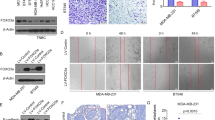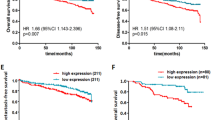Abstract
Breast cancer is the most common type of cancer among women worldwide, and metastasis represents the most devastating stage of the disease. Recent studies have revealed that microRNAs (miRNA) have critical roles to regulate cancer cell invasion and metastasis. Here we present evidence to show the role of miR-182 in breast cancer metastasis. miR-182 is upregulated in the malignant cell line variants of both human MCF10 and mouse 4T1 series. Ectopic expression of miR-182 enhanced breast cancer cell motility and invasiveness, whereas miR-182 inhibition resulted in opposite changes. In nude mice, miR-182 led to increased pulmonary colonization of cancer cells. We further demonstrated that miR-182 directly targets MIM (Missing in Metastasis), which suppresses metastasis by inhibiting ras homolog family member A (RhoA) activity and stress fiber formation in breast cancer cells. Restoring MIM expression completely blocked the pro-metastasis function of miR-182, while RhoA inhibition reversed the phenotypes of both miR-182 overexpression and MIM knockdown. In breast tumor samples, miR-182 induction is linked to downregulation of MIM, RhoA activation and poor prognosis. Hence, our data delineates the molecular pathway by which miR-182 promotes breast cancer invasion and metastasis, and may have important implication for the treatment of metastatic cancers.
This is a preview of subscription content, access via your institution
Access options
Subscribe to this journal
Receive 50 print issues and online access
$259.00 per year
only $5.18 per issue
Buy this article
- Purchase on Springer Link
- Instant access to full article PDF
Prices may be subject to local taxes which are calculated during checkout






Similar content being viewed by others
References
Jemal A, Bray F, Center MM, Ferlay J, Ward E, Forman D . Global cancer statistics. CA Cancer J Clin 2011; 61: 69–90.
Xu S, Witmer PD, Lumayag S, Kovacs B, Valle D . MicroRNA (miRNA) transcriptome of mouse retina and identification of a sensory organ-specific miRNA cluster. J Biol Chem 2007; 282: 25053–25066.
Moskwa P, Buffa FM, Pan Y, Panchakshari R, Gottipati P, Muschel RJ et al. miR-182-mediated downregulation of BRCA1 impacts DNA repair and sensitivity to PARP inhibitors. Mol Cell 2011; 41: 210–220.
Stittrich AB, Haftmann C, Sgouroudis E, Kuhl AA, Hegazy AN, Panse I et al. The microRNA miR-182 is induced by IL-2 and promotes clonal expansion of activated helper T lymphocytes. Nat Immunol 2010; 11: 1057–1062.
Saus E, Soria V, Escaramis G, Vivarelli F, Crespo JM, Kagerbauer B et al. Genetic variants and abnormal processing of pre-miR-182, a circadian clock modulator, in major depression patients with late insomnia. Hum Mol Genet 2010; 19: 4017–4025.
Guttilla IK, White BA . Coordinate regulation of FOXO1 by miR-27a, miR-96, and miR-182 in breast cancer cells. J Biol Chem 2009; 284: 23204–23216.
Sun Y, Fang R, Li C, Li L, Li F, Ye X et al. Hsa-mir-182 suppresses lung tumorigenesis through down regulation of RGS17 expression in vitro. Biochem Biophys Res Commun 2010; 396: 501–507.
Segura MF, Hanniford D, Menendez S, Reavie L, Zou X, Alvarez-Diaz S et al. Aberrant miR-182 expression promotes melanoma metastasis by repressing FOXO3 and microphthalmia-associated transcription factor. Proc Natl Acad Sci USA 2009; 106: 1814–1819.
Huynh C, Segura MF, Gaziel-Sovran A, Menendez S, Darvishian F, Chiriboga L et al. Efficient in vivo microRNA targeting of liver metastasis. Oncogene 2011; 30: 1481–1488.
Jiang L, Mao P, Song L, Wu J, Huang J, Lin C et al. miR-182 as a prognostic marker for glioma progression and patient survival. Am J Pathol 2010; 177: 29–38.
Liu Z, Liu J, Segura MF, Shao C, Lee P, Gong Y et al. MiR-182 overexpression in tumourigenesis of high-grade serous ovarian carcinoma. J Pathol 2012; 228: 204–215.
Callahan CA, Ofstad T, Horng L, Wang JK, Zhen HH, Coulombe PA et al. MIM/BEG4, a Sonic hedgehog-responsive gene that potentiates Gli-dependent transcription. Genes Dev 2004; 18: 2724–2729.
Gonzalez-Quevedo R, Shoffer M, Horng L, Oro AE . Receptor tyrosine phosphatase-dependent cytoskeletal remodeling by the hedgehog-responsive gene MIM/BEG4. J Cell Biol 2005; 168: 453–463.
Dawson JC, Timpson P, Kalna G, Machesky LM . Mtss1 regulates epidermal growth factor signaling in head and neck squamous carcinoma cells. Oncogene 2011; 31: 1781–1793.
Mattila PK, Salminen M, Yamashiro T, Lappalainen P . Mouse MIM, a tissue-specific regulator of cytoskeletal dynamics, interacts with ATP-actin monomers through its C-terminal WH2 domain. J Biol Chem 2003; 278: 8452–8459.
Woodings JA, Sharp SJ, Machesky LM . MIM-B, a putative metastasis suppressor protein, binds to actin and to protein tyrosine phosphatase delta. Biochem J 2003; 371: 463–471.
Lin J, Liu J, Wang Y, Zhu J, Zhou K, Smith N et al. Differential regulation of cortactin and N-WASP-mediated actin polymerization by missing in metastasis (MIM) protein. Oncogene 2005; 24: 2059–2066.
Yamagishi A, Masuda M, Ohki T, Onishi H, Mochizuki N . A novel actin bundling/filopodium-forming domain conserved in insulin receptor tyrosine kinase substrate p53 and missing in metastasis protein. J Biol Chem 2004; 279: 14929–14936.
Saarikangas J, Mattila PK, Varjosalo M, Bovellan M, Hakanen J, Calzada-Wack J et al. Missing-in-metastasis MIM/MTSS1 promotes actin assembly at intercellular junctions and is required for integrity of kidney epithelia. J Cell Sci 2011; 124: 1245–1255.
Lee YG, Macoska JA, Korenchuk S, Pienta KJ . MIM, a potential metastasis suppressor gene in bladder cancer. Neoplasia 2002; 4: 291–294.
Wang Y, Liu J, Smith E, Zhou K, Liao J, Yang GY et al. Downregulation of missing in metastasis gene (MIM) is associated with the progression of bladder transitional carcinomas. Cancer Invest 2007; 25: 79–86.
Parr C, Jiang WG . Metastasis suppressor 1 (MTSS1) demonstrates prognostic value and anti-metastatic properties in breast cancer. Eur J Cancer 2009; 45: 1673–1683.
Liu K, Wang G, Ding H, Chen Y, Yu G, Wang J . Downregulation of metastasis suppressor 1(MTSS1) is associated with nodal metastasis and poor outcome in Chinese patients with gastric cancer. BMC Cancer 2010; 10: 428.
Xie F, Ye L, Chen J, Wu N, Zhang Z, Yang Y et al. The impact of Metastasis Suppressor-1, MTSS1, on oesophageal squamous cell carcinoma and its clinical significance. J Transl Med 2011; 9: 95.
Nixdorf S, Grimm MO, Loberg R, Marreiros A, Russell PJ, Pienta KJ et al. Expression and regulation of MIM (Missing In Metastasis), a novel putative metastasis suppressor gene, and MIM-B, in bladder cancer cell lines. Cancer Lett 2004; 215: 209–220.
Ma S, Guan XY, Lee TK, Chan KW . Clinicopathological significance of missing in metastasis B expression in hepatocellular carcinoma. Hum Pathol 2007; 38: 1201–1206.
Wang D, Xu MR, Wang T, Li T, Zhu J . MTSS1 overexpression correlates with poor prognosis in colorectal cancer. J Gastrointest Surg 2011; 15: 1205–1212.
Bompard G, Sharp SJ, Freiss G, Machesky LM . Involvement of Rac in actin cytoskeleton rearrangements induced by MIM-B. J Cell Sci 2005; 118: 5393–5403.
Du P, Ye L, Ruge F, Yang Y, Jiang WG . Metastasis suppressor-1, MTSS1, acts as a putative tumour suppressor in human bladder cancer. Anticancer Res 2011; 31: 3205–3212.
Xie F, Ye L, Ta M, Zhang L, Jiang WG . MTSS1: a multifunctional protein and its role in cancer invasion and metastasis. Front Biosci 2011; 3: 621–631.
Aslakson CJ, Miller FR . Selective events in the metastatic process defined by analysis of the sequential dissemination of subpopulations of a mouse mammary tumor. Cancer Res 1992; 52: 1399–1405.
Lu X, Bennet B, Mu E, Rabinowitz J, Kang Y . Metabolomic changes accompanying transformation and acquisition of metastatic potential in a syngeneic mouse mammary tumor model. J Biol Chem 2010; 285: 9317–9321.
Strickland LB, Dawson PJ, Santner SJ, Miller FR . Progression of premalignant MCF10AT generates heterogeneous malignant variants with characteristic histologic types and immunohistochemical markers. Breast Cancer Res Treat 2000; 64: 235–240.
Santner SJ, Dawson PJ, Tait L, Soule HD, Eliason J, Mohamed AN et al. Malignant MCF10CA1 cell lines derived from premalignant human breast epithelial MCF10AT cells. Breast Cancer Res Treat 2001; 65: 101–110.
Kang Y, Siegel PM, Shu W, Drobnjak M, Kakonen SM, Cordon-Cardo C et al. A multigenic program mediating breast cancer metastasis to bone. Cancer Cell 2003; 3: 537–549.
Friedman RC, Farh KK, Burge CB, Bartel DP . Most mammalian mRNAs are conserved targets of microRNAs. Genome Res 2009; 19: 92–105.
Krek A, Grun D, Poy MN, Wolf R, Rosenberg L, Epstein EJ et al. Combinatorial microRNA target predictions. Nat Genet 2005; 37: 495–500.
Hicks DG, Yoder BJ, Short S, Tarr S, Prescott N, Crowe JP et al. Loss of breast cancer metastasis suppressor 1 protein expression predicts reduced disease-free survival in subsets of breast cancer patients. Clin Cancer Res 2006; 12: 6702–6708.
Acharya PS, Majumdar S, Jacob M, Hayden J, Mrass P, Weninger W et al. Fibroblast migration is mediated by CD44-dependent TGF beta activation. J Cell Sci 2008; 121: 1393–1402.
Sahai E, Marshall CJ . RHO-GTPases and cancer. Nat Rev Cancer 2002; 2: 133–142.
Li H, Kloosterman W, Fekete DM . MicroRNA-183 family members regulate sensorineural fates in the inner ear. J Neurosci 2010; 30: 3254–3263.
Gokhale A, Kunder R, Goel A, Sarin R, Moiyadi A, Shenoy A et al. Distinctive microRNA signature of medulloblastomas associated with the WNT signaling pathway. J Cancer Res Ther 2010; 6: 521–529.
Hall A . The cytoskeleton and cancer. Cancer Metastasis Rev 2009; 28: 5–14.
Ebert MS, Neilson JR, Sharp PA . MicroRNA sponges: competitive inhibitors of small RNAs in mammalian cells. Nat Methods 2007; 4: 721–726.
Rajnicek AM, Foubister LE, McCaig CD . Temporally and spatially coordinated roles for Rho, Rac, Cdc42 and their effectors in growth cone guidance by a physiological electric field. J Cell Sci 2006; 119: 1723–1735.
Hu G, Chong RA, Yang Q, Wei Y, Blanco MA, Li F et al. MTDH activation by 8q22 genomic gain promotes chemoresistance and metastasis of poor-prognosis breast cancer. Cancer Cell 2009; 15: 9–20.
Sethi N, Dai X, Winter CG, Kang Y . Tumor-derived JAGGED1 promotes osteolytic bone metastasis of breast cancer by engaging notch signaling in bone cells. Cancer Cell 2011; 19: 192–205.
Acknowledgements
We thank Dr Eva Hernando for providing the miR-182 overexpression plasmid. The study was funded by the grants from the Ministry of Science and Technology of China (2011CB510105, 2012ZX09506-001-005), National Natural Science Foundation of China (81071754,81222032), Chinese Academy of Sciences (2009OHTP08, KSCX2-YW-R-192) and the Shanghai Pujiang Talent Program (10PJ1411600).
Author information
Authors and Affiliations
Corresponding author
Ethics declarations
Competing interests
The authors declare no conflict of interest.
Additional information
Supplementary Information accompanies this paper on the Oncogene website
Supplementary information
Rights and permissions
About this article
Cite this article
Lei, R., Tang, J., Zhuang, X. et al. Suppression of MIM by microRNA-182 activates RhoA and promotes breast cancer metastasis. Oncogene 33, 1287–1296 (2014). https://doi.org/10.1038/onc.2013.65
Received:
Revised:
Accepted:
Published:
Issue Date:
DOI: https://doi.org/10.1038/onc.2013.65
Keywords
This article is cited by
-
The oncogenic role of HIF-1α/miR-182-5p/ZFP36L1 signaling pathway in nasopharyngeal carcinoma
Cancer Cell International (2021)
-
MTSS1 suppresses mammary tumor-initiating cells by enhancing RBCK1-mediated p65 ubiquitination
Nature Cancer (2020)
-
FOXF2 deficiency accelerates the visceral metastasis of basal-like breast cancer by unrestrictedly increasing TGF-β and miR-182-5p
Cell Death & Differentiation (2020)
-
miR-182 suppresses invadopodia formation and metastasis in non-small cell lung cancer by targeting cortactin gene
Journal of Experimental & Clinical Cancer Research (2018)
-
Bone protection by inhibition of microRNA-182
Nature Communications (2018)



